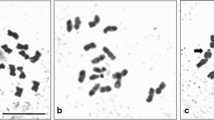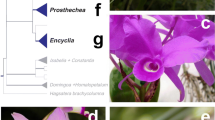Abstract
Analysis of C-band heterochromatin (CBH) and cold-induced secondary constrictions (CICs) indicates that gynogenetic triploidy in the Ambystoma jeffersonianum complex is a cytogenetic consequence of hybridization between the two diploid species, A. jeffersonianum and A. laterale. The key feature in the history of this complex was the apparent proclivity for germ-line chromosome reduplication, and incidental production of chromosomally unreduced ova, allowing the circumvention of meiotic difficulties in diploid hybrid females. Chromosome structure, in terms of CBH and CICs, the mechanism of sex determination (dominant W, female heterogametic), and a recognizable WZ female/ZZ male sex chromosome heteromorphism in the diploid species A. laterale, are cytogenetic factors that allow reconstruction of the probable evolutionary history of the complex. The constitution of the triploid karyotypes suggests that the putative ancestral hybrid diploid females resulted from a mating between female A. jeffersonianum and male A. laterale, and that when such a hybrid female backcrossed to normal males of A. jeffersonianum and A. laterale, both kinds of allotriploids, A. platineum and A. tremblayi respectively, were produced. Karyological differentiation in each triploid species suggests that their origin was relatively recent and virtually simultaneous. It is conceivable that only one such hybrid female gave rise to both kinds of allotriploids in just one or two breeding seasons, and that present geographic distributions are due to persistent post-glaciation migrations of the resulting triploid clones. All offspring from such a back-cross carried a jeffersonianum W-chromosome and hence were female as well as triploid, and probably continued to produce chromosomally unreduced (triploid) ova by the same mechanism that operated in their hybrid mother. Sperm rejection resulting in gynogenesis in the allotriploids can be viewed as a physiological response to “pseudopolyspermy” by the chromosomally unreduced triploid ova. Evidence is presented that one of the triploid species, A. platineum, may produce a high percentage of diploid offspring with karyotypes identical to A. jeffersonianum. Diploids have not been detected among the offspring of A. tremblayi, but tetraploids are occasionally produced.
Similar content being viewed by others
References
Bogart, J.P.: Evolutionary implications of polyploidy in amphibians and reptiles. In: Polyploidy (W.H. Lewis, ed.), pp. 341–378. New York: Plenum Press 1980
Callan, H.G.: Chromosomes and nucleoli of the axolotl, Ambystoma mexicanum. J. Cell. Sci. 1, 85–108 (1966)
Clanton, W.: An unusual situation in the salamander Ambystoma jeffersonianum (Green). Occ. Pap. Mus. Zool. Univ. Mich. 290, 1–40 (1934)
Conant, R.: A field guide to reptiles and amphibians of eastern and central North America. 2nd ed. Boston: Houghton-Mifflin Co., 1975
Cook, F.R., Gorham, S.W.: The occurrence of the triploid form in populations of the blue-spotted salamander, Ambystoma laterale, in New Brunswick. J. New Brunswick Mus. 154–161 (1979)
Cueller, O.: On the origin of parthenogenesis in vertebrates; the cytogenetic factors. Amer. Naturalist 108, 625–648 (1974)
Cuellar, O.: Cytology of meiosis in the driploid gynogenetic salamander Ambystoma tremblayi. Chromosoma (Berl.) 58, 355–364 (1976)
Downs, F.L.: Unisexual Ambystoma from the Bass Islands of Lake Erie. Occ. Pap. Mus. Zool. Univ. Mich. 685, 1–36 (1978)
Gilhen, J.: Distribution, natural history and morphology of the blue-spotted salamanders, Ambystoma laterale and A. tremblayi in Nova Scotia. Nova Scotia Mus. Curatorial Report number 22, 1–38 (1974)
Graham, R.E.: Environmental effects on deme structure, dynamics and breeding strategy of Ambystoma opacum (Amphibia: Ambystomatidae), with an hypothesis on the probable origin of the marbled salamander life-style. PhD dissertation, Rutgers University (1971)
Green, D.M., Bogart, J.P., Anthony, E.H., Genner, D.H.: An interactive, microcomputer-based karyotype analysis system for phylogenetic cytotaxonomy. Comput. Biol. Med. 10, 219–227 (1980)
Hadorn, E.: Experimental studies of amphibian development. Berlin, Heidelberg, New York: Springer (1974)
Hauschka, T.S., Brunst, V.V.: Sexual dimorphism in the nucleolar autosome of the axolotl (Siredon mexicanum). Hereditas (Lund) 52, 345–356 (1965)
Hotta, Y., Stern, H.: DNA scission and repair during pachytene in Lilium. Chromosoma (Berl.) 46, 279–296 (1974)
Humphrey, R.R.: Sex determination in ambystomid salamanders: a study of the progeny of females experimentally converted into males. Amer. J. Anat. 76, 33–66 (1945)
Humphrey, D.G.: New chromosome number for the order Caudata. Science 128, 304 (1958)
John, B., Miklos, G.L.G.: Functional aspects of satellite DNA and heterochromatin. Int. Rev. Cytol. 58, 1–114 (1979)
Kezer, J.: Meiosis in salamander spermatocytes. In: The mechanics of inheritance (F.W. Stahl). 2nd ed. Englewood Cliffs, N.J.: Prentice-Hall Inc. (1969)
Kezer, J., León, P., Sessions, S.K.: Struktural differentiation of the meiotic and mitotic chromosomes of the salamander, Ambystoma macrodactylum. Chromosoma (Berl.) 81, 177–197 (1980)
Kiester, A.R. Nagylaki, T., Shaffer, B.: Population dynamics of species with gynogenetic sibling species. Theoret. Pop. Biol. 19, 358–369 (1981)
Koch, P., Pijnacker, L.P., Kreke, J.: DNA reduplication during meiotic prophase in the oocytes of Carausius, morosus Br. (Insecta, Cheleutoptera). Chromosoma (Berl.) 36, 313–321 (1972)
Levan, A., Fredga, D., Sandberg, A.A.: Nomenclature for centromeric position on chromosomes. Hereditas (Lund) 52, 201–220 (1964)
Lewin, B.: Gene expression, vol. 2, eucaryotic chromosomes. 2nd ed. John Wiley and Sons, New York, Chichester, Krisbane, Toronto (1980)
Macgregor, H.C.: The role of lampbrush chromosomes in the formation of nucleoli in amphibian oocytes. Quart. J. Micr. Sci. 106, 215–228 (1965)
Macgregor, H.C., Uzzell, T.M., Jr.: Gynogenesis in salamanders related to Ambystoma jeffersonianum. Science 143, 1032–1046 (1964)
Mancino, G., Ragghianti, M., Bucci-Innocenti, S.: Experimental hybridization within the genus Triturus (Urodele: Salamandridae). I. Spermatogenesis of F1 species hybrids, Triturus cristatus carnifex x T. vulgaris meridionalis. Chromosoma (Berl.) 69, 27–46 (1978)
Minton, S.A., Jr.: Salamanders of the Ambystoma jeffersonianum complex in Indiana. Herpetologica 10, 173–179 (1954)
Morescalchi, A.: Chromosome evolution in the caudate amphibia. Evol. Biol. 8, 339–387 (1975)
Noble, G.K., Brady, M.K.: Observations on the life history of the marbled salamander, Ambystoma opacum Gravenhorst. Zoologica 8, 89–132 (1933)
Ohno, S.: Evolution by gene duplication. Berlin, Heidelberg, New York: Springer (1970)
Piersol, W.H.: Spawn and larva of Ambystoma jeffersonianum. Am. Nat. 44, 732–738 (1910)
Piersol, W.H.: Pathological polyspermy in eggs of Ambystoma jeffersonianum. Trans. Roy. Can. Inst. 17, 57–74 (1929)
Schmid, M., Olert, J., Klett, C.: Chromosome banding in amphibia. III. Sex chromosomes in Triturus. Chromosoma (Berl.) 71, 29–55 (1979)
Uzzell, T.M., Jr.: Natural triploidy in salamanders related to Ambystoma jeffersonianum. Science 139, 113–115 (1963)
Uzzell, T.M., Jr.: Relations of the diploid and triploid species of the Ambystoma jeffersonianum complex (Amphibia, Caudata) Copeia 2, 257–300 (1964)
Uzzell, T.M., Jr.: Ambystoma jeffersonianum. In: Catalogue of American amphibians and reptiles. American Society of Ichthyologists and Herpetologists. p. 47 (1967 a)
Uzzell, T.M., Jr.: Ambystoma laterale. In: Catalogue of American amphibians and reptiles. American Society of Ichthyologists and Herpetologists, p. 48 (1967 b)
Uzzell, T.M., Jr.: Ambystoma platineum. In: Catalogue of American amphibians and reptiles. American Society of Ichthyologists and Herpetologists. p. 49 (1967 c)
Uzzell, T.M., Jr.: Ambystoma tremblayi. In: Catalogue of American amphibians and reptiles. American Society of Ichthyologists and Herpetologists. p. 50 (1967 d)
Uzzell, T.M., Jr., Goldblatt, S.M.: Serum proteins of salamanders of the Ambystoma jeffersonianum complex, and the origin of the triploid species of this group. Evolution 21, 345–354 (1967)
Walker, P.M.B.: ‘Repetitive’ DNA in higher organisms. Progr. biophys. molec. Biol. 23, 145–190 (1971)
White, M.J.D.: Animal cytology and evolution, 3rd ed. Cambridge: Cambridge Univ. Press, (1973)
White, R., Pasztor, L.M., Hu, F.: Mouse satellite DNA in noncentromeric heterochromatin of cultured cells. Chromosoma (Berl.) 50, 275–282 (1975)
Woodard, J., Swift, H.: The DNA content of cold treated chromosomes. Exptl. Cell Res. 34, 131–137 (1964)
Yunis, J.J., Yasmineh, W.G.: Heterochromatin, satellite DNA, and cell function. Science 174, 1200–1209 (1971)
Author information
Authors and Affiliations
Additional information
Dedicated to my mentor and valued friend, James Kezer
Rights and permissions
About this article
Cite this article
Sessions, S.K. Cytogenetics of diploid and triploid salamanders of the Ambystoma jeffersonianum complex. Chromosoma 84, 599–621 (1982). https://doi.org/10.1007/BF00286329
Received:
Issue Date:
DOI: https://doi.org/10.1007/BF00286329




